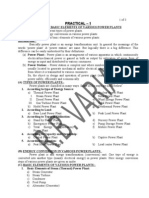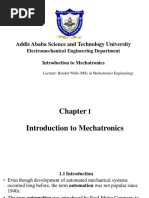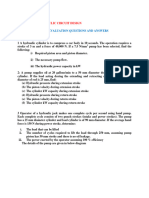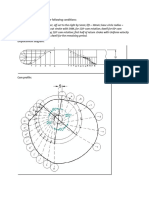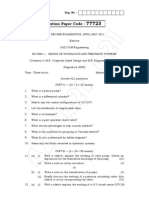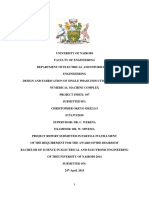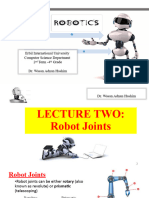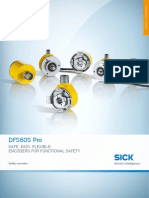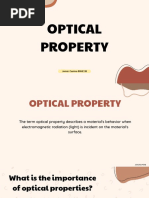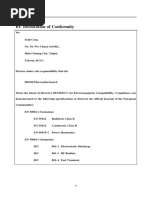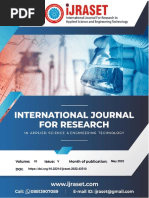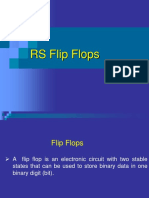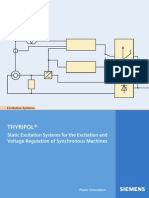0 ratings0% found this document useful (0 votes)
125 viewsActuation Systems For Mechatronics
Actuation Systems For Mechatronics
Uploaded by
abdulkerim seidThe document discusses actuation systems for mechatronics. It describes the main types of actuators as electrical, mechanical, hydraulic and pneumatic. Electrical actuators like DC motors, stepper motors and AC motors are commonly used. They are easy to control and provide high torque. Pneumatic and hydraulic systems use compressed air or liquids respectively to transfer power and produce motion. Mechanical systems are also used to change motion types or amplify forces. The document outlines the different types of motion and degrees of freedom for joints and linkages.
Copyright:
© All Rights Reserved
Available Formats
Download as PDF, TXT or read online from Scribd
Actuation Systems For Mechatronics
Actuation Systems For Mechatronics
Uploaded by
abdulkerim seid0 ratings0% found this document useful (0 votes)
125 views26 pagesThe document discusses actuation systems for mechatronics. It describes the main types of actuators as electrical, mechanical, hydraulic and pneumatic. Electrical actuators like DC motors, stepper motors and AC motors are commonly used. They are easy to control and provide high torque. Pneumatic and hydraulic systems use compressed air or liquids respectively to transfer power and produce motion. Mechanical systems are also used to change motion types or amplify forces. The document outlines the different types of motion and degrees of freedom for joints and linkages.
Original Title
Introduction_to_Mechatronics_Chapter2
Copyright
© © All Rights Reserved
Available Formats
PDF, TXT or read online from Scribd
Share this document
Did you find this document useful?
Is this content inappropriate?
The document discusses actuation systems for mechatronics. It describes the main types of actuators as electrical, mechanical, hydraulic and pneumatic. Electrical actuators like DC motors, stepper motors and AC motors are commonly used. They are easy to control and provide high torque. Pneumatic and hydraulic systems use compressed air or liquids respectively to transfer power and produce motion. Mechanical systems are also used to change motion types or amplify forces. The document outlines the different types of motion and degrees of freedom for joints and linkages.
Copyright:
© All Rights Reserved
Available Formats
Download as PDF, TXT or read online from Scribd
Download as pdf or txt
0 ratings0% found this document useful (0 votes)
125 views26 pagesActuation Systems For Mechatronics
Actuation Systems For Mechatronics
Uploaded by
abdulkerim seidThe document discusses actuation systems for mechatronics. It describes the main types of actuators as electrical, mechanical, hydraulic and pneumatic. Electrical actuators like DC motors, stepper motors and AC motors are commonly used. They are easy to control and provide high torque. Pneumatic and hydraulic systems use compressed air or liquids respectively to transfer power and produce motion. Mechanical systems are also used to change motion types or amplify forces. The document outlines the different types of motion and degrees of freedom for joints and linkages.
Copyright:
© All Rights Reserved
Available Formats
Download as PDF, TXT or read online from Scribd
Download as pdf or txt
You are on page 1of 26
Chapter II
Actuation systems for
Mechatronics
2. Actuation Systems
• Actuation systems are the elements of control systems which are
responsible for transforming the output of a microprocessor or
control system into a controlling action on a machine of device:
• Most common types of actuators
1. Electric Actuator
2. Mechanical Actuators
3. Hydraulic & Pneumatic Actuator
Intr. to Mechatronics Prepare by: Bereket 2
2. Actuation Systems
1. Electrical Actuators are machines/devices that convert electrical
energy to mechanical energy.
• DC Motors
• Stepper Motors
• AC Motors
• Linear Motors (read by your self)
• Solenoids are also electrical actuator used within
mechatronic systems
Intr. to Mechatronics Prepare by: Bereket 3
2. Actuation Systems
A. Electrical Actuators are
• Easy to control
• From mw to MW
• Normally high velocities 1000 - 10000 rpm
• Several types
• Ideal torque for driving
• Excellent efficiency
Intr. to Mechatronics Prepare by: Bereket 4
2. Actuation Systems
DC Motors
• The most common actuator in Mechatronic systems is the DC motor
Rotary actuators
Power range: Fractions of watts to 100s of kW.
Easy to control accurately
Advantages:
Simple, cheap,
Various sizes and packages.
Disadvantages:
Limited overloading on high speeds
Wear at rubbing surfaces
Intr. to Mechatronics Prepare by: Bereket 5
2. Actuation Systems
Basic Operation
Current flowing through a conductor in a magnetic field induces a
force perpendicular to the field and to itself.
Intr. to Mechatronics Prepare by: Bereket 6
2. Actuation Systems
Stepper Motors
Intr. to Mechatronics Prepare by: Bereket 7
2. Actuation Systems
Permanent magnet stepper motors
• Rotor is a permanent magnet and the stator is an electromagnet
• Rotor field is switched to create a rotating magnetic field
Variable reluctance stepper motors
• The rotor is made of soft steel (ferromagnetic)
• Motion is based on the attraction of rotor and stator poles
to position with minimum
• magnetic reluctance which allows maximum magnetic flux.
Intr. to Mechatronics Prepare by: Bereket 8
2. Actuation Systems
Intr. to Mechatronics Prepare by: Bereket 9
2. Actuation Systems
Principle of operation
Intr. to Mechatronics Prepare by: Bereket 10
2. Actuation Systems
Stepper Motor Applications
Intr. to Mechatronics Prepare by: Bereket 11
2. Actuation Systems
• More accurately controlled than a normal motor allowing
fractional turns or revolutions to be easily done
• Low speed, and lower torque than a comparable D.C. motor
• Useful for precise positioning
Intr. to Mechatronics Prepare by: Bereket 12
2. Actuation Systems
AC-motors
Intr. to Mechatronics Prepare by: Bereket 13
2. Actuation Systems
AC-motors
Intr. to Mechatronics Prepare by: Bereket 14
2. Actuation Systems
AC motors: Some applications
• Large Cranes or material handling systems
• Belts or conveyors
• High Speed Trains
• Electric Drive Haul Trucks (930E)
Selection of a motor for a particular application is based
on Moment of inertia, Torque, Power and Cost.
Intr. to Mechatronics Prepare by: Bereket 15
2. Actuation Systems
B. Pneumatic Power Actuation
• Pneumatic actuation is widely used in the manufacturing industry
primarily in the field of automated system.
• Assembly, including jig and robot end-effector operation.
• Pneumatic power generally utilizes pressurized air as the power
transfer medium.
• Pneumatic power lies is used both for pneumatic power modulation
as well as for energy transfer devices
• The use of air as the operating fluid.
• The primary type of energy transfer device found in pneumatics is
the pneumatic cylinder.
Intr. to Mechatronics Prepare by: Bereket 16
2. Actuation Systems
• The motion of the cylinder occurs by applying pressurized air at one
of two ports found at the ends of the cylinder.
Figure: Pneumatic actuation operation.
Intr. to Mechatronics Prepare by: Bereket 17
2. Actuation Systems
C. Hydraulic Power Actuation
• Hydraulic fluid power basic operating principles are quite similar to
those of pneumatic fluid power systems.
• The difference in operating fluid, i.e. from air or gas in pneumatic
systems to liquids (generally oil) in hydraulics.
• Primarily, the use of liquids allows the achievement of very high
operating pressures
• Used where large forces and torques need to be applied.
• Hydraulic actuators can both be of a linear as well as a rotary nature.
Intr. to Mechatronics Prepare by: Bereket 18
2. Actuation Systems
• The difference lies in the robustness of the cylinders; In hydraulics
are designed to be capable with higher operating pressures thus are
made from steel with appropriate wall thickness whereas, in
pneumatic system it built from thin-walled aluminum.
• Hydraulic motors are quite commonly used where large torques
need to be transmitted and generally offer a higher power-to-weight
ratio when compared to electrical motors
Intr. to Mechatronics Prepare by: Bereket 19
2. Actuation Systems
D. Mechanical systems
• Although in mechatronics system microprocessor/electronic systems
are being used for many functions that previously were fulfilled by
mechanism; mechanisms are still being used to provide the following
functions:
1. Force amplification e.g. levers
2. Change of speed e.g. gears
3. Transfer of rotation about one axis to rotation about another axis e.g. belt
4. Devices that transform motion from one form to some other required form.
Eg: Transform linear motion into rotational motion and vice versa.
rack-and-pinion can be used to convert rotational motion to linear
motion.
Intr. to Mechatronics Prepare by: Bereket 20
2. Actuation Systems
Types of Motion
• The motion of any rigid body can be considered to be a combination of translation and
rotational motions.
• Translation motion is a movement which can be resolved into components along one or
more of the three axis x,y or z.
• A rotational motion is one which has components rotating about one or more of the axis
Translation motion Rotational motion
Intr. to Mechatronics Prepare by: Bereket 21
2. Actuation Systems
Types of Motion…
• A complex motion is the combination of
the translation and rotation motions
Eg. Instruct a robot to pickup a pencil
from a table: you should breakup
motion into small simple motion,
e.g. instruct joint 1 to rotate by
x degree then link 2 to be extended
by 4 mm….etc
Intr. to Mechatronics Prepare by: Bereket 22
2. Actuation Systems
Freedom & Constraints
• Freedom and constraints; A body that is free in space can move in three
independent, mutually perpendicular directions and rotate in three ways
about those directions. It is said to have six degree of freedom
• The number of degrees of freedom are the number of components of
motion that are required in order to generate the motion
• If a joint is constrained to move along a line then it has one degree
of freedom
• If a joint is constraint to move on a plane then it has two degree of
freedom
Intr. to Mechatronics Prepare by: Bereket 23
2. Actuation Systems
• Figure (a) shows a joint with just this one translational degree of freedom.
• Figure (b) shows a joint which has one translational degree of freedom one
rotational degree of freedom.
Intr. to Mechatronics Prepare by: Bereket 24
2. Actuation Systems
• The problem in a design is to reduce the number of degrees of freedom which
requires an appropriate number and orientation of constraint.
Fixed body implies zero degree of freedom implies 6 constraints
Concept in design: In fixing a body or guiding it to a particular type of
motion, the minimum number of constraints should be used “kinematics
design”
Intr. to Mechatronics Prepare by: Bereket 25
End of Chapter II
You might also like
- Design of Electrical Machine Unit 1 2 MarksDocument6 pagesDesign of Electrical Machine Unit 1 2 MarksVel MuruganNo ratings yet
- Pedal Operated HacksawDocument2 pagesPedal Operated HacksawvasanthavananNo ratings yet
- Case Study 8C Design of Spur Gears For A Compressor Drive TrainDocument4 pagesCase Study 8C Design of Spur Gears For A Compressor Drive TrainZaqueu123No ratings yet
- Study of Basic Elements of Various Power PlantsDocument3 pagesStudy of Basic Elements of Various Power PlantsRajendrakumar B Varia67% (3)
- Pneumatic FeedersDocument5 pagesPneumatic FeedersKaramveer RatheeNo ratings yet
- Illustrated Parts Data For RADIO TradeDocument37 pagesIllustrated Parts Data For RADIO TradeMD AL Amin RajNo ratings yet
- ActuatorDocument4 pagesActuatorArbaz Khan0% (1)
- Addis Ababa Science and Technology University: Electromechanical Engineering Department Introduction To MechatronicsDocument52 pagesAddis Ababa Science and Technology University: Electromechanical Engineering Department Introduction To Mechatronicsabdulkerim seid100% (2)
- Smart WiperDocument22 pagesSmart WiperAmit Bakle100% (1)
- Actuation SystemDocument11 pagesActuation SystemNavendu GuptaNo ratings yet
- Pneumatic Sheet Metal Shearing MachineDocument21 pagesPneumatic Sheet Metal Shearing MachineGamerNo ratings yet
- Unit III Temporary and Permanent JointsDocument42 pagesUnit III Temporary and Permanent JointsJayashree rajamuruganNo ratings yet
- Chapter 7 Pneumatic and Hydraulic SystemsDocument32 pagesChapter 7 Pneumatic and Hydraulic SystemsRoyal Ritesh SharmaNo ratings yet
- Chapter-4: Determination of State of DamageDocument21 pagesChapter-4: Determination of State of Damagekit akeNo ratings yet
- Mechatronic System ElementDocument73 pagesMechatronic System ElementAbhijit AtoliyaNo ratings yet
- Bushed-Pin CouplingDocument12 pagesBushed-Pin CouplingNishanth Madhavan100% (3)
- Hydraulics Lab Viva QDocument2 pagesHydraulics Lab Viva QSiva JothiNo ratings yet
- Chapter Three: FUNDAMENTALS OF CUTTING PROCESS: The Common Feature Is The Use of A Cutting Tool To FormDocument12 pagesChapter Three: FUNDAMENTALS OF CUTTING PROCESS: The Common Feature Is The Use of A Cutting Tool To FormkidusNo ratings yet
- VCloudPoint Zero Client User ManualDocument109 pagesVCloudPoint Zero Client User ManualAnieshKumartrNo ratings yet
- Solar Wheel ChairDocument4 pagesSolar Wheel ChairJournalNX - a Multidisciplinary Peer Reviewed JournalNo ratings yet
- R19 - Mech - Turbo Machinery - Mechanical - Sample Questions Bank PDFDocument9 pagesR19 - Mech - Turbo Machinery - Mechanical - Sample Questions Bank PDFSangam JadhavNo ratings yet
- Workout Worksheet On ConveyorsDocument1 pageWorkout Worksheet On ConveyorsMartha BelayNo ratings yet
- Pneumatics System: Operation of A Single Acting Cylinder Controlled by 3-Way ValveDocument14 pagesPneumatics System: Operation of A Single Acting Cylinder Controlled by 3-Way ValveMubarak ShehuNo ratings yet
- Unit-3.1.3-Gib and Cotter JointDocument28 pagesUnit-3.1.3-Gib and Cotter JointAsvath GuruNo ratings yet
- Unit 6: Stability of Linear Control SystemDocument14 pagesUnit 6: Stability of Linear Control SystemNasrullah YusupNo ratings yet
- CH 3Document28 pagesCH 3bro100% (1)
- Belt Drive Types Material Applications Advantages Disadvantages PPT 1Document19 pagesBelt Drive Types Material Applications Advantages Disadvantages PPT 1Sandesh yadavNo ratings yet
- Techo GeneratorDocument18 pagesTecho GeneratorBhola KumarNo ratings yet
- Super-High Frequency Models and Behaviour PDFDocument23 pagesSuper-High Frequency Models and Behaviour PDFalokinxxNo ratings yet
- Calculations On Sizing Hydraulic Circuits FinalDocument13 pagesCalculations On Sizing Hydraulic Circuits FinalJimmy KariukiNo ratings yet
- Unit 6 CAD ELECTRICAL MACHINEDocument5 pagesUnit 6 CAD ELECTRICAL MACHINEPradhunya KambleNo ratings yet
- Design and Fabrication of Button Operated Gear ShifterDocument18 pagesDesign and Fabrication of Button Operated Gear Shiftersnehar redkarNo ratings yet
- Group Project DESIGN CASE STUDY FOR POWER TRANSMISSIONDocument14 pagesGroup Project DESIGN CASE STUDY FOR POWER TRANSMISSIONrayan alnoaimiNo ratings yet
- Lab Report 2: BTM 2243 Fluid Power TechnologyDocument5 pagesLab Report 2: BTM 2243 Fluid Power TechnologyIbrahim AdhamNo ratings yet
- Design and Structural Analysis of Inbuilt Car Jack SystemDocument5 pagesDesign and Structural Analysis of Inbuilt Car Jack SystemAshish Kumar GarhwalNo ratings yet
- Ideal Vs Real OttoDocument5 pagesIdeal Vs Real Ottoa7med SoulimanNo ratings yet
- Chapter 4-ppt - PDF/ InstrumentationDocument46 pagesChapter 4-ppt - PDF/ Instrumentationregassa rajiNo ratings yet
- Lecture 39 PDFDocument23 pagesLecture 39 PDFmyusuf_engineerNo ratings yet
- Introduction To Manufacturing Technology - Lecture 3Document53 pagesIntroduction To Manufacturing Technology - Lecture 3venkat4No ratings yet
- Chapter 5. Ultra Low Temperature Refrigeration SystemsDocument35 pagesChapter 5. Ultra Low Temperature Refrigeration SystemsHosnii QamarNo ratings yet
- Mechanical Actuation SystemsDocument14 pagesMechanical Actuation SystemsnkchandruNo ratings yet
- Bahir Dar University Bahir Dar Institute of Technology Faculity of Mechanical and Industrial Engineering Industrial Engineering DepartmentDocument13 pagesBahir Dar University Bahir Dar Institute of Technology Faculity of Mechanical and Industrial Engineering Industrial Engineering DepartmentTamr KasayeNo ratings yet
- B Tech - 6 Sem (CBGS) Course Code: ME 602 Subject Name: Machine Component & Design Important Questions Unit - 1Document6 pagesB Tech - 6 Sem (CBGS) Course Code: ME 602 Subject Name: Machine Component & Design Important Questions Unit - 1suneel kumar rathoreNo ratings yet
- Question Bank On Comparator Chapter I. Fill in The BlanksDocument9 pagesQuestion Bank On Comparator Chapter I. Fill in The BlanksMohammed AseerNo ratings yet
- BLDC Obj QuestionsDocument4 pagesBLDC Obj QuestionsRAMESH P (PC2013005013009)No ratings yet
- 215 Sample ChapterDocument23 pages215 Sample ChapterSreekumar RajendrababuNo ratings yet
- Draw The Cam Profile For Following ConditionsDocument3 pagesDraw The Cam Profile For Following ConditionsmaloyNo ratings yet
- Kom Unit 1Document24 pagesKom Unit 1Muthuvel M100% (2)
- Pelton TurbineDocument13 pagesPelton TurbineHitarth ShahNo ratings yet
- Jig DesignDocument23 pagesJig DesignЦырен ЖалсаповNo ratings yet
- Design and Fabrication of Portable Concrete Mixture Machine Ijariie7611Document5 pagesDesign and Fabrication of Portable Concrete Mixture Machine Ijariie7611Bizuayehu ShibiruNo ratings yet
- Chapter 8 PDFDocument29 pagesChapter 8 PDFYoseph MershaNo ratings yet
- Abrasive Jet MachineDocument39 pagesAbrasive Jet MachineMuhammad Suleman100% (1)
- ExergyDocument30 pagesExergyRooth Adajet100% (1)
- Design of Hydraulics and Pneumatic Systems-April-2011Document2 pagesDesign of Hydraulics and Pneumatic Systems-April-2011SasiKumar Petchiappan100% (1)
- Design and Fabrication of Single Phase Induction Motor For Numerical Machine ComplexDocument55 pagesDesign and Fabrication of Single Phase Induction Motor For Numerical Machine Complexmugisa aloysiousNo ratings yet
- Projectreportmain PDFDocument36 pagesProjectreportmain PDFAnshul TailorNo ratings yet
- Lecture No 2Document25 pagesLecture No 2Walid salamaNo ratings yet
- LectureTwo Roboticsjoint DrWasanDocument23 pagesLectureTwo Roboticsjoint DrWasanwasan.engNo ratings yet
- PDFDocument32 pagesPDFdinesh kNo ratings yet
- 1.1 IntroductionDocument15 pages1.1 IntroductionAlphaBravoNo ratings yet
- Ology Quick GuideDocument31 pagesOlogy Quick GuideFernando RuizNo ratings yet
- Anemometro ManualDocument8 pagesAnemometro Manualjose norberto santillan zazuetaNo ratings yet
- DFS60S Pro: Safe, Easy, Flexible: Encoders For Functional SafetyDocument36 pagesDFS60S Pro: Safe, Easy, Flexible: Encoders For Functional SafetyDanielNo ratings yet
- DD Domofonija Cenovnik 2Document5 pagesDD Domofonija Cenovnik 2UshtNo ratings yet
- Orphee Mythic 22-CT Hematology Analyzer - User ManualDocument102 pagesOrphee Mythic 22-CT Hematology Analyzer - User ManualAna Laura Ochoa ZepedaNo ratings yet
- Development Research FINALDocument22 pagesDevelopment Research FINALDave AycoNo ratings yet
- Amplaid A137 and A177 Plus PuretoneDocument2 pagesAmplaid A137 and A177 Plus PuretonePau Choon HockNo ratings yet
- List of Important Books For GATE - FaaDoOEngineersDocument12 pagesList of Important Books For GATE - FaaDoOEngineersHari VarmaNo ratings yet
- Primesim Continuum DsDocument2 pagesPrimesim Continuum Dssiddhantsukale9096No ratings yet
- Lecture-Block Diagram Reduction (Compatibility Mode)Document21 pagesLecture-Block Diagram Reduction (Compatibility Mode)Miera SmaelzNo ratings yet
- Fisa Tehnica Pompa Submersibila EvoplusDocument54 pagesFisa Tehnica Pompa Submersibila EvoplusCristina OanaNo ratings yet
- iXP Manual ENG V1.0Document114 pagesiXP Manual ENG V1.0Justice KNo ratings yet
- PCB Layout DesignDocument74 pagesPCB Layout DesignMallappa Patil100% (2)
- Optical Properties Jomarcastinobsme2bDocument10 pagesOptical Properties Jomarcastinobsme2bDan Bryan ApaNo ratings yet
- Title: Physics On The Guitar Original: Revision: Authors: Appropriate Level: AbstractDocument19 pagesTitle: Physics On The Guitar Original: Revision: Authors: Appropriate Level: AbstractBoris GoitiaNo ratings yet
- Gadgetman Mapster InfoDocument4 pagesGadgetman Mapster InfoEduardo WakuiNo ratings yet
- EC Declaration of ConformityDocument64 pagesEC Declaration of ConformityiammiaNo ratings yet
- A Power Quality Improved EV Charger by Using Bridgeless CUK ConverterDocument15 pagesA Power Quality Improved EV Charger by Using Bridgeless CUK ConverterIJRASETPublications100% (1)
- No. 20621-034E A: 0 Toshiba Medical Manufacturing CO., LTD. 2004-2005 All Rights ReservedDocument20 pagesNo. 20621-034E A: 0 Toshiba Medical Manufacturing CO., LTD. 2004-2005 All Rights ReservedAriangel MasoNo ratings yet
- New Topic 1 Introduction To Power System 2 Det30053Document41 pagesNew Topic 1 Introduction To Power System 2 Det30053Atikah ZamriNo ratings yet
- PVS-175-TL 9AKK107046A3492 EN Rev CDocument4 pagesPVS-175-TL 9AKK107046A3492 EN Rev CSAEL SOLARNo ratings yet
- RS Flip FlopDocument14 pagesRS Flip FlopNelson RajaNo ratings yet
- Cambridge International AS & A Level: PHYSICS 9702/42Document22 pagesCambridge International AS & A Level: PHYSICS 9702/42bhattmaneet6No ratings yet
- Vitromap - Pulse OximeterDocument2 pagesVitromap - Pulse OximeterAlliance distributorNo ratings yet
- Delta PLC ManualDocument7 pagesDelta PLC ManualRoyal Ritesh SharmaNo ratings yet
- 11 Thyripol Main Project FileDocument11 pages11 Thyripol Main Project FileKirankumar Reddy100% (1)
- PV FuturaSun 450W Silk ProDocument2 pagesPV FuturaSun 450W Silk Prona3nou3-ocs.za3zou3No ratings yet
- Name: Mahmoud Yasser Elsayed ID: 17746 - Mti Main Components of ComputerDocument19 pagesName: Mahmoud Yasser Elsayed ID: 17746 - Mti Main Components of Computerwaniaye derickNo ratings yet
- Lecture28 Operational AmplifierDocument17 pagesLecture28 Operational AmplifierOm Prakash MahatoNo ratings yet



